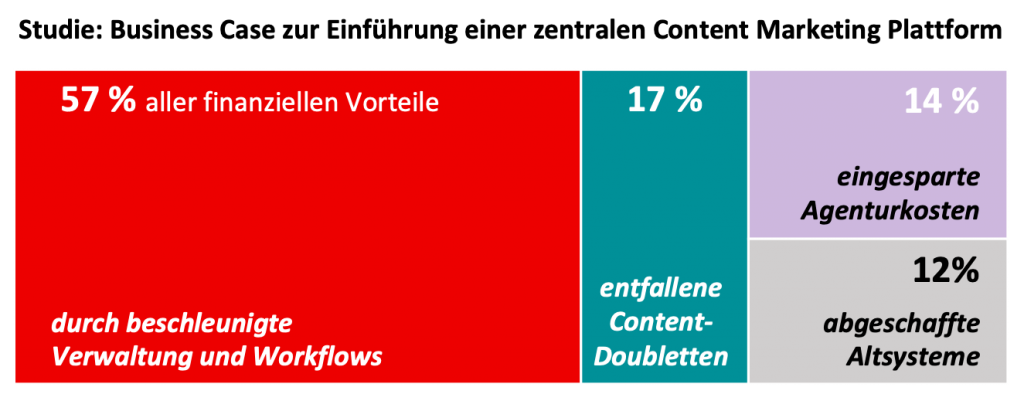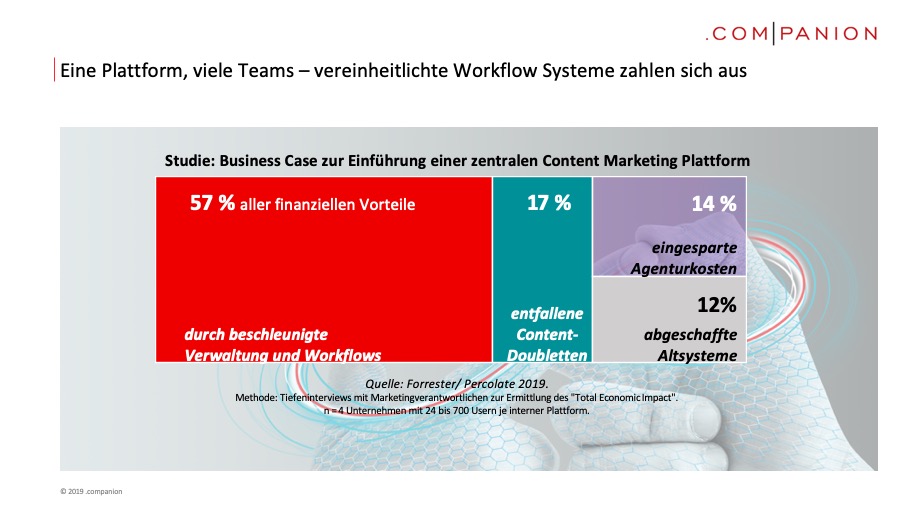Good content wins through. So does that of our software colleagues at Percolate. They usually deliver an enterprise platform to unify marketing workflows across many distributed teams. But every once in a while, they also deliver research data for organizing content and marketing within the enterprise. Here is an interesting overview of how the not inconsiderable investment in a content marketing platform (CMP) is usually refinanced.
One platform, many teams - unified workflow systems pay off
CMP have many functions, but usually they are a collaboration platform first. The most common second use is as a system for maintaining brand assets, i.e., logos, photos, etc. In a study for Percolate - which you can also request directly HERE - Forrester examined the economic effects of a CMP. In-depth interviews were conducted with managers in four large companies that already use a CMP, asking them about their goals and experiences. The data collected in this way was transferred into a model calculation (Total Economic Impact). It makes concrete statements about the type and size of the financial benefits that arise in the first 3 years after the introduction of such a system.
However vulnerable the figures and the model may be in detail, the tendency of the results fully coincides with our experience from 10 years of confidential discussions with the many content marketing managers at more than 40 specialist days of our Web Excellence Forum.
The most important takeaway from the study: by far the greatest financial leverage lies in organization and processes. This refers to completely superfluous administrative and process costs, which are only due to the notorious organizational deficiencies and silo thinking in marketing. If a company with distributed teams migrates to a common CMP, the more efficient workflows alone generate 60% of the refinancing effects.
Unified KPIs link leadership with execution
And what does this have to do with KPIs for performance and impact? Quite simply: they are the necessary second platform alongside the CMP - if the KPIs are standardized. This requires universal digital KPIs, which no single ready-made tool can deliver, but an internal or external service can, such as our 3 KPI Dashboard service. Its KPIs apply to ALL digital channels, whether web, social, native, video, adwords or CRM.
Content marketing teams that use unified KPIs no longer manage silos, but topics or campaigns. They no longer speak analytics jargon, but an easily understandable common language for evaluating the production, publication, and promotion of their own content. This goes down well with the marketing team, but is often not understood at the executive level because - in fact - it is "too far down", meaningful only for the operational level.
The link between leadership and execution only occurs in a second step, when the team data on its own performance is related to the data that makes a statement about impact , i.e. media resonance, brand building or sales success. If it's about one of these three topics, all bosses listen. But listening is not enough. Data that is not used is of no use.
Fragmentarized communication - those who do not merge internally have no future
Does it make sense to invest in collaboration or analysis environments? This question is decided by project and daily routines. Under the conditions of a fragmented media world, it is the regular team meetings that must be planned first and to which all concepts for CMPs and KPIs must be subordinated.
Executives facing digital challenges and implementing a platform for unified marketing processes will therefore focus on organizational issues. That's right, and it's also an ideal opportunity to empower teams to leverage the data they have. To do this, they need management tools in the form of simple control templates and intelligent team and project routines. They are the key to scaling, to continuous learning, to continued value creation after implementing a CMP tool.
The above study only shows the world of (reduced) costs. However, the actual value creation is not shown in the figures. It is the marketing successes that arise and the innovations that are released as soon as the new processes begin to repeat themselves, to loop.
Marketing and innovation produce results; all the rest are costs.
Since it fits so well right now and there are surely some Marketeers who don't yet know the legendary quote by Peter F. Drucker, the "guru of management gurus" - here is Drucker's /.companion's core idea for leadership in marketing in all its concise glory. Please tattoo:
"Because the purpose of business is to create a customer, the business enterprise has two-and only two-basic functions: marketing and innovation. Marketing and innovation produce results; all the rest are costs. Marketing is the distinguishing, unique function of the business." 1974



